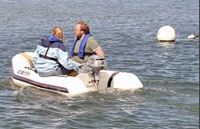5 Basics For Guest In Dinghies
1. Loading And Unloading

Don't assume everyone knows how to get in and out of a dinghy. You may be carrying children, older folks, or people who've just never done it. First, secure the dinghy painter to the mother ship. Next, when people are boarding, stress the importance of stepping down all the way into the floor of the dinghy, toward the middle, and sitting pronto; don't have them step on the inflatable tubes or on the gunwales of a rigid dink. Everyone's center of gravity should be kept low from the second they board; keep people seated underway.
2. Beach Landings
If beach landings are the only way to come ashore, explain beforehand what will happen. Time your ride to surf in with a wave, and pull the motor up before it grounds. Have your strongest passenger jump out first and pull the dink into shallow water, then everyone can hop out, grab a handhold, and pull the dinghy onto the beach quickly. Proper water footwear with straps is important.
3. Night Moves
Finding your boat in the dark can be a challenge. Ask everyone to keep the flashlights off to preserve your night vision until you get near the boat and are ready to tie up and unload. A solar garden light tied to a stanchion provides an inexpensive nighttime marker low on the mother ship at the height where people in a dinghy are usually looking. Also, battery-powered LED lights in various colors, such as blue, can be suspended from dodgers or towers and won't drain your onboard energy reserves. Make sure lights such as these don't conflict with lighting required by the Navigation Rules.
4. NavIGATION Lights
Most tenders require only a 360-degree white transom light when running at night. If your dinghy exceeds a speed of 7 knots or is more than 23 feet long, you’ll need red and green bow lights along with a white stern light.
5. Davit Dilemma
Although dealing with davits may be second nature to you, for guests, it's all new. If you ask others to help you raise or power the tender, caution them to keep fingers and long hair away from any blocks or pinch points that could cause injury. Wrap davit lines around a winch or cleat to help hold the dinghy's weight. Dinghies, especially with outboards, are heavy, and too often guests lose control of the line and drop the boat abruptly. Advise that both ends should be raised or lowered evenly and that the drain plug needs to be in before the boat goes in the water. It also must be taken out after the boat is up. If the boat were to fill with rain, the weight could be far too much for the davits. If the big boat has its exhaust aft above the waterline, turn the engine off before lowering the dink and filling it with hot water. Stress the importance of loosely tying the painter to the mother ship before unclipping the davit lines.